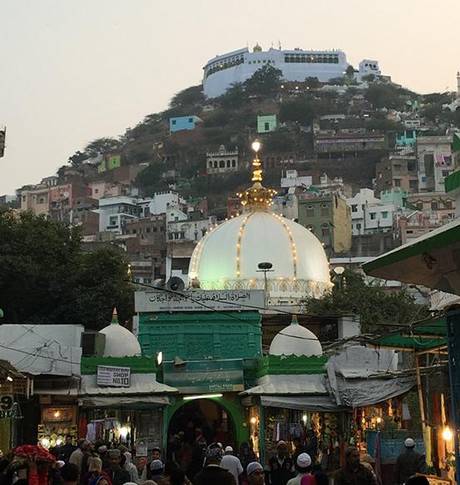By Rana Safvi
Khwaja Moinuddin Chishti attracted kings and peasants alike to his discourses
The name Ajmer immediately conjures up a vision of Khwaja Garib Nawaz and his dargah. It reminds me of the saint Moinuddin Hasan Chishti, who was generous like the sea and hospitable like the earth. Today, his dargah, with its saintly white dome and golden crown, hosts millions of devotees who soak in the generosity of his blessings. It was this affection and love for all of humanity that earned Moinuddin Hasan Chishti the name Khwaja Garib Nawaz, or cherisher of the poor.Devotees from far and wide
Moinuddin Hasan Chishti was born in Sijistan (modern-day Sistan) in Iran in 1141-42 CE. After receiving Khilafat at the age of 52 from Sheikh Usman Harawani, he went on Hajj to Mecca and Medina. While he was praying in the Prophet’s mosque in Medina, the Khwaja is said to have heard the Prophet telling him to go to Hindustan and to the city of Ajmer.
At that time, he had no idea where Ajmer was. However, he proceeded via Baghdad and Herat to Lahore and thence to Delhi and Ajmer. Muizuddin Muhammad bin Sam of Ghor had already defeated Prithviraj Chauhan and established his rule in Delhi. Khwaja Moinuddin Chishti started living and preaching in Ajmer. His instructive discourses, full of spiritual insights, soon drew the local populace as well as kings and nobles and peasants and the poor from far and wide.
The shrine has been visited by Muhammad bin Tughlaq, Sher Shah Suri, Akbar, Jahangir, Shah Jahan, Dara Shukoh, Jahanara Begum and Aurangzeb, among many others. Even today, filmstars and heads of states, both the rich and the poor make a pilgrimage to the shrine.
Construction and additions
The original dargah was made of wood, write Carl W. Ernst and Bruce B. Lawrence in Sufi Martyrs of Love. A stone canopy was built over it later. When Mahmud Khilji, the Sultan of Malwa, conquered Ajmer in 1455, no concrete structure had been built over the grave of Khwaja Moinuddin Chishti.
The first concrete evidence we get of construction in the dargah complex is the cupola of the shrine that was embellished in 1532, as indicated in an inscription written in golden letters in the northern wall of the tomb. This is the beautiful dome we see today. In keeping with Indo-Islamic architecture, a lotus adorns the dome and a golden crown offered by Nawab Haider Ali Khan of Rampur sits on top of it.
Most of the additions made to the shrine were done during the reign of Akbar, by the emperor himself. Akbar first visited the shrine in 1562 after he heard wandering minstrels singing the praise of Khwaja Moinuddin Chishti as he was returning from a hunt. He decided to proceed to Ajmer immediately. Thus began his annual pilgrimage.
In 1568, Akbar offered a degh, or brass cauldron, for cooking of langar. This was ensconced at the entrance. Another cauldron was offered by Jahangir in 1614. It is placed opposite the first cauldron. Both cauldrons are in use today. Devotees offer sacks of rice and wheat for the gruel that is cooked here. Only vegetarian food is cooked in this dargah.
Akbar gave instructions to build mosques and khanqahs in Ajmer in 1569. The Akbari mosque of red sandstone is probably a result of those orders. An elegant mosque was also built by Shah Jahan in 1637 and is to the west of the shrine, along with the Shah Jahani Darwaza.
A sense of peace
I walked into the dargah through the dargah bazaar and through the well-decorated Nizami Gate, which is yellow with floral designs. This was built in 1911 by British engineers at the behest of the Nizam of Hyderabad. The Naqqar Khana, or drum house, is next to it. It is from here that ensembles would have once played music to greet visitors to the Khwaja’s threshold. A huge silver chandelier hangs here. This was presented by the Golden Temple committee to the dargah.
From here I walked through the courtyards into the Ihaata Noorani, or Quarter of Light, where the main shrine is located. The smell of incense and flowers greeted me.
A railing around the main shrine was offered by Jahanara Begum, the Sufi princess and daughter of Shah Jahan. Jahanara Begum also built a small platform in front of the other door that is known as Begumi Chabutra after her title of Padshah Begum.
There are two doors that go into the main sanctum. Devotees enter it with baskets of flowers, chadors to be offered to the Khwaja. As we wait our turn to enter the dargah, a sense of peace prevails. This is one dargah where women are allowed. A silver and mother of pearl canopy offered by Jahangir can be seen on four silver posts above the cenotaph. The rest of it is covered in flowers and chadors.


